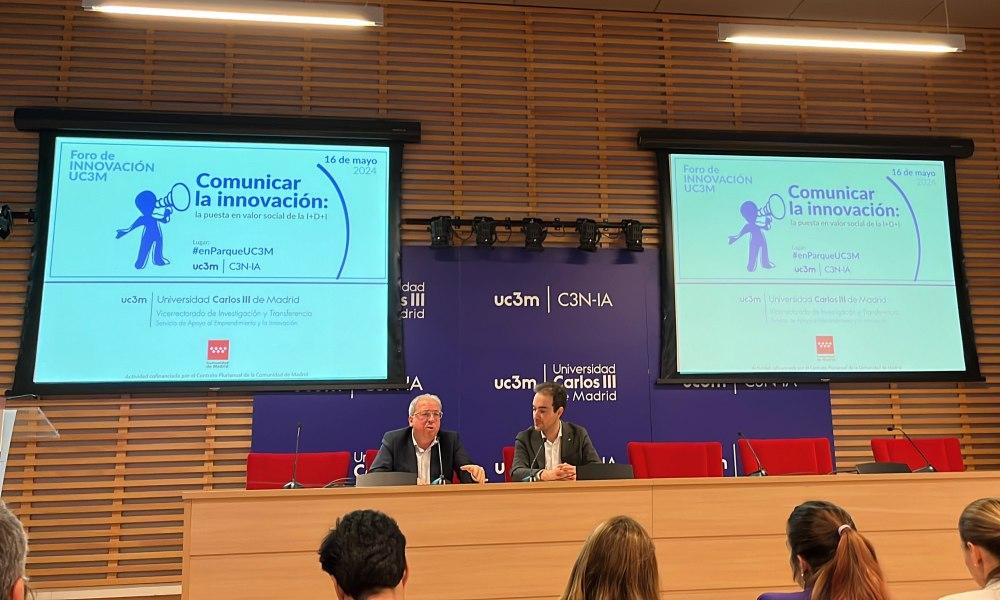Communicating innovation provides social value to R&D&I
According to the conclusions of UC3M’s 2024 Innovation Forum
5/22/24
Public communication of innovation is crucial in order to give social value to the efforts and results of the Spanish R&D&I ecosystem. This is one of the main conclusions drawn from the latest Innovation Forum held at the Universidad Carlos III de Madrid (UC3M), which brought together more than twenty speakers in this field.

The event, held at the UC3M Science Park’s Centre for Innovation in Entrepreneurship and Artificial Intelligence (C3N-IA), was opened by the Community of Madrid’s Deputy Director of Technological Innovation, Vicente Parras, and the University’s Deputy Vice Rector for Innovation, Transfer and the Science Park, Mario Merino. The latter, in his speech, pointed out that more than half of the companies (19 of the 36) supported by UC3M’s Science Park develop AI serving different economic sectors.
During the introduction to the event, Beatriz Rosique, the head of external promotion of the Vice Rector's Office for Research and Transfer who announced that she is leaving her position upon retirement, spoke about the origins of this event, which go back a decade. It was in 2012, with the project “Communicating Innovation”, which was supported by the Spanish Foundation for Science and Technology (FECYT, in its Spanish acronym) and consisted of a meeting at the Círculo de Bellas Artes with some of the major players in this field.
The first round table, focusing on the contribution and dialogue of innovation sources and players and moderated by Atlas Tecnológico journalist, Eugenio Mallol, was attended by: Elena Chavarría, communication manager at the multinational Thales; Emilio Corchado, creator of StartupOlé; Soledad Díaz, manager of the Association of Science and Technology Parks (APTE, in its Spanish acronym); Mónica de la Fuente, marketing manager of the company AEQ, Eva López, head of marketing and communication at the Technological Institute of Computer Science (ITI/Fedyt, in its Spanish acronym); and Lluís Santamaría, a UC3M lecturer and co-head of the University's Spanish Innovation Index (ÍEI, in its Spanish acronym).
Some key ideas on innovation sources and players
- “Without communication and innovation there is no transformation; they must go hand in hand”, Eugenio Mallol.
- “When you have a close relationship with a journalist, previously overlooked issues to report may arise in the company”, Elena Chavarría.
- “The communication team must be aligned with the vision and values that the CEO wants to project”, Emilio Corchado.
- “It's important to filter the valuable information to detect where the innovation really is”, Soledad Díaz.
- “The important thing about technology isn’t the technology itself, but what you do with it”, Mónica de la Fuente.
- “It's not only what you say and how you say it that’s important, but also when you say it”, Eva López.
- “Consumer perception is valuable information for redefining a company's communication policies”, Lluís Santamaría.
Later, journalist Juanma Romero, director of Emprende TVE, gave a talk on how to become visible with AI and empathy. “If you have a good idea but you don’t know how to communicate it, it’s as if you never had it”, he said in his talk, alluding to a quote by Pericles (“Having knowledge but lacking the power to express it clearly is no better than never having any ideas at all”). In this sense, he pointed out that the spokespeople have to know how to communicate and relate to journalists.
The event’s next round table, focusing on the contribution of R&D&I communication channels and media, was moderated by the founder and CEO of inBusiness 5.0, Francisco Hortigüela, and was attended by: Pilar Alcázar, editor of Emprendedores magazine; Andrés Dulanto, editor-in-chief of the EFE Agency; Susana Herrera, professor of journalism and director of the Innovation on Digital Media Group at UC3M; Alberto Iglesias, director of Disruptores at El Español; María Lacalle, business development at Innovaspain; Eva Lorente, CEO of the LorenteComunicaciónagency.
Some key ideas about R&D&I communication channels and media
- “Advertising is what you say about yourself, communication is what others say about you”, Francisco Hortigüela.
- “Not every entrepreneur is newsworthy, but must be innovative”, Pilar Alcázar.
- “We must condemn what is being done badly and explain what is being done well in R&D&I journalism”, Andrés Dulanto.
- “The university can provide examples of good practice in innovation communication from the academic field”, Susana Herrera.
- “Journalists and the media have critical work to do; the challenge is separating the wheat from the chaff because there's also a lot of posturing and selling smoke in this field”, Alberto Iglesias.
- “We are interested in explaining innovation as a process to change the economic and social model”, María Lacalle.
- “It is not enough to promote a project, you also have to publicise what is being done”, Eva Lorente.
The event was concluded by the moderators of the round tables together with the academic director of UC3M's Office of Information and Dissemination of Science and Innovation (OIDCI, in its Spanish acronym), Elías Sanz. The latter highlighted the importance of communication for knowledge transfer: “The University makes a great effort in research and innovation, but in order to transform this into results, processes and services that are passed on to society, good public communication of R&D&I is also necessary”.
Finally, there was a workshop on the value of public communication of R&D&I for research staff, given by Fco. Javier Alonso, technical manager of the UC3M Scientific Culture and Innovation Unit (UCC+i, in its Spanish acronym), who spoke about the benefits of public communication of science at the institutional level.
